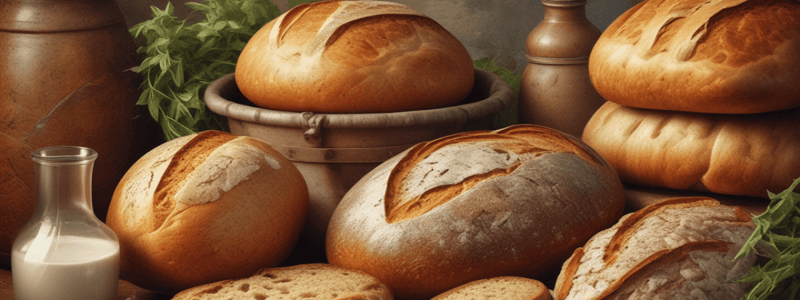Podcast
Questions and Answers
What happens to thiol compounds in the presence of oxygen?
What happens to thiol compounds in the presence of oxygen?
- They strengthen the gluten proteins
- They develop disulfide bonds
- They are put out of commission (correct)
- They improve the baking quality of the flour
What is the primary reason for oxidizing flour before using it in bread production?
What is the primary reason for oxidizing flour before using it in bread production?
- To reduce the aging process of the flour
- To improve the flavor of the bread
- To enhance the nutritional value of the bread
- To develop disulfide bonds and improve the baking quality (correct)
What is the result of not oxidizing flour sufficiently before baking?
What is the result of not oxidizing flour sufficiently before baking?
- The gluten matrix will not develop fully (correct)
- The bread will have a better volume and structure
- The aging process will be accelerated
- The bread will have a stronger flavor
How is the oxidizing of flour best achieved?
How is the oxidizing of flour best achieved?
What is the primary function of disulfide bonds in bread production?
What is the primary function of disulfide bonds in bread production?
What happens to the gluten matrix if the flour is not oxidized sufficiently?
What happens to the gluten matrix if the flour is not oxidized sufficiently?
Why is it important to avoid overoxidizing dough in the mixer?
Why is it important to avoid overoxidizing dough in the mixer?
Why can freshly milled whole grains be mixed as soon as possible?
Why can freshly milled whole grains be mixed as soon as possible?
What is the primary reason why modern mills do not store flour for a sufficient amount of time to allow for natural aging?
What is the primary reason why modern mills do not store flour for a sufficient amount of time to allow for natural aging?
What is the consequence of using flour that is unaged or underaged in bread making?
What is the consequence of using flour that is unaged or underaged in bread making?
What is the purpose of adding oxygen to flour during the mixing process?
What is the purpose of adding oxygen to flour during the mixing process?
What is the result of overmixing the dough?
What is the result of overmixing the dough?
What is the effect of excessive mixing on the natural pigments in unbleached flour?
What is the effect of excessive mixing on the natural pigments in unbleached flour?
How does the temperature of the dough affect its oxidation?
How does the temperature of the dough affect its oxidation?
What is the alternative to natural aging of flour?
What is the alternative to natural aging of flour?
What is the consequence of using chemically treated and artificially oxidized flour?
What is the consequence of using chemically treated and artificially oxidized flour?
Study Notes
Oxidizing Flour
- Freshly milled white flour needs to be oxidized before use in baking, unlike whole grains which can be mixed immediately.
- Oxidation occurs when flour is exposed to oxygen, which helps to strengthen gluten proteins by developing disulfide bonds.
- Thiol compounds, present in freshly milled flour, block the development of disulfide bonds, but are neutralized by oxygen.
Aging of Flour
- The best way to oxidize flour is to let it age naturally for 3-4 weeks before baking, allowing oxygen to penetrate the flour.
- Natural aging stabilizes the flour and improves its baking quality.
- Flour that is not aged or underaged is called "green flour", resulting in poor bread quality.
Alternative to Natural Aging
- Chemical treatment can be used to artificially oxidize flour, but this has negative effects on flour and baked breads.
- Bleach and other artificial oxidants are commonly used in the US, but have negative consequences.
Mixing and Oxidizing Dough
- Mixing flour with water in the mixer incorporates oxygen, which helps develop gluten bonds.
- Overmixing can lead to overoxidizing, breaking down gluten structure, weakening dough, and destroying carotenoid pigments.
- Overmixing can also cause dough to become shiny and sticky, and lose its natural color and aroma.
Important Considerations
- Dough temperature affects oxidation rate, with warm dough oxidizing more quickly than cool dough.
- Careful attention to dough temperatures is necessary to prevent overoxidizing.
Studying That Suits You
Use AI to generate personalized quizzes and flashcards to suit your learning preferences.
Description
Learn about the importance of oxidizing flour in bread production and the precautions to avoid overoxidizing in the mixer. Understand the role of oxidation in enhancing nutrition and flavor.




